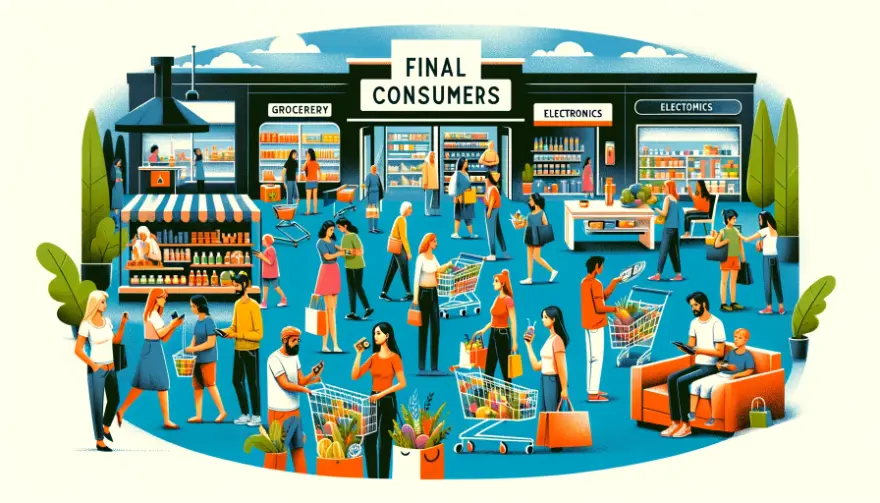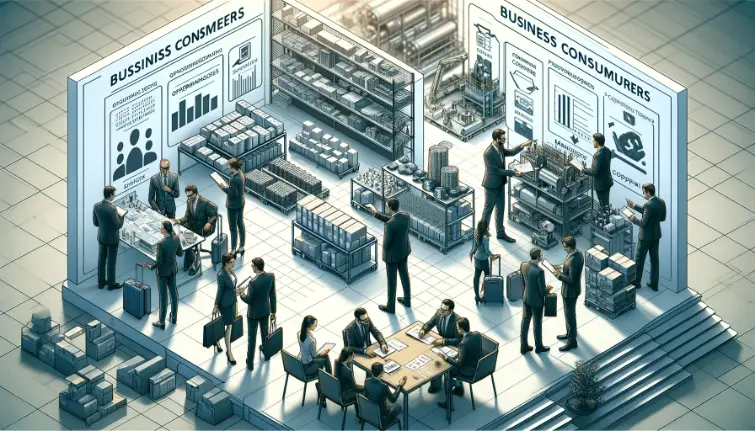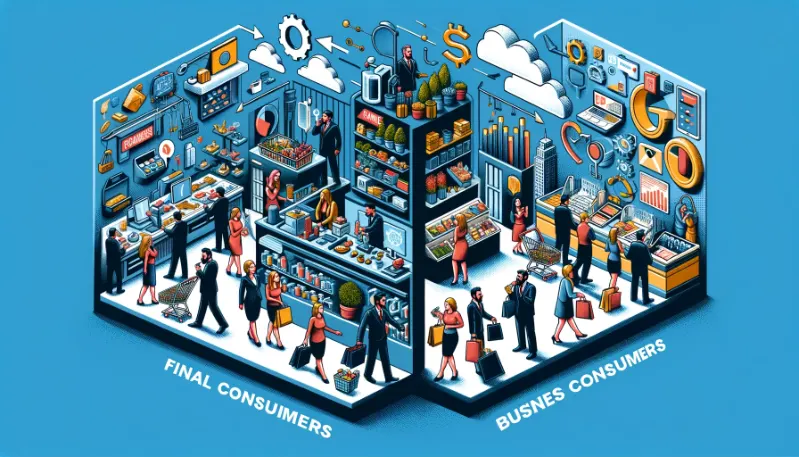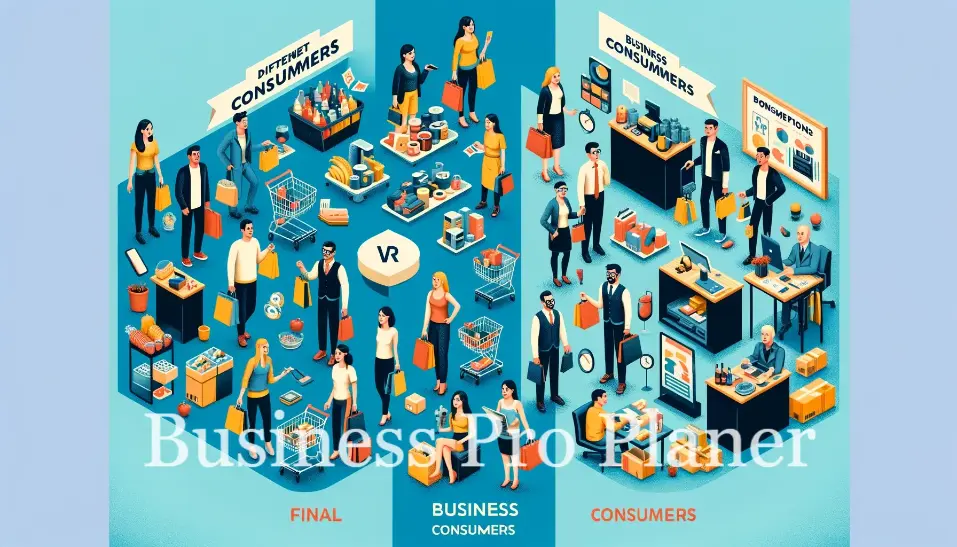In today’s diverse marketplace, understanding what is the difference between final consumers and business consumers is crucial. Consumer markets represent a significant portion of economic transactions, comprised of final consumers purchasing goods and services for personal use.
However, the business market is also massive, with business organizations buying products to operate their companies. Although these groups may appear similar initially, a closer look reveals significant differences in their profiles and behaviors. Suppliers must comprehend these distinctions thoroughly to adeptly cater to these distinct customer segments.
This post compares final consumers and business consumers. Examining motivations, goods, process complexity, and marketing strategies reveals interesting distinctions. Numerous examples will be seamlessly integrated to illustrate each point. Let’s start by formally defining these two buyer categories and establishing a shared understanding of who they consist of.
Understanding Final Consumers and Business Consumers
Final Consumers:
Final consumers refer to individuals or households purchasing products and services for personal use and consumption. They represent the ultimate end users who buy goods like consumer electronics, cars, clothing, food items, etc. to fulfill their own needs, wants, and desires rather than for commercial objectives.

Some examples of final consumers include students buying books for their studies, families purchasing groceries for daily household consumption, an individual ordering a fitness band for health tracking requirements, and so on. The key motivation for these buyers centers around deriving personal utility, value, and happiness from using the products/services. Their buying behavior is influenced by factors like pricing, brand reputation, quality, features, and how well these align with their requirements.
Marketers sell goods directly to final consumers through retail stores and digital channels. Understanding characteristics like demographics, preferences, and buying patterns allows them to devise consumer-focused marketing strategies for improving sales conversions. Thus, for suppliers, individual consumers comprise a key target audience with distinct needs served by segmenting product offerings accordingly.
Business Consumers:
Business consumers, on the other hand, are organizations that purchase goods or services for operational purposes, including reselling, as inputs for production, or for the overall functioning of the organization. These include manufacturers, wholesalers, retailers, and various service providers. Their purchases are typically part of a business transaction within the B2B (Business to Business) market.

For example, a manufacturing company purchasing raw materials for production or a retailer buying goods for resale. These transactions are fundamental components of the supply chain. Business consumers’ motivations are driven by the need to support, maintain, or grow their business operations. Recognizing these motivations is key for suppliers and B2B companies to tailor their offerings and direct marketing efforts effectively.
Key Differences Between Final Consumers and Business Consumers
In the realm of commerce, distinguishing between final consumers and business consumers is pivotal. These two groups have distinct characteristics that influence their purchasing behavior, marketing strategies, and overall market dynamics. Below is a professional table outlining the key differences:

| Basis of Comparison | Final Consumers | Business Consumers |
|---|---|---|
| Purchasing Role | Buy products or services for personal consumption and use | Purchase goods and services to support business operations |
| Type of Goods | Consumer goods like food items, cars, appliances, clothing, electronics, etc. | Raw materials, equipment, components, business services, etc. |
| Purchasing Motives | Satisfying personal needs, desires, and interests | Enabling organizational processes, revenue generation through resale/use |
| Buying Process | Individual decision-making, informal | Formal procurement processes, multiple decision-makers |
| Marketing Strategy | Mass marketing focuses on individual personas and lifestyles | Niche marketing tailored to industry/business demographics |
| Pricing | Price sensitivity is higher, so seek consumer deals | Focus on quality, and service levels rather than just low prices |
| Distribution Channels | Retail stores, online consumer channels | Business representative engagement, trade exhibitions |
Key Differences Summary
As illustrated above, final customers and business buyers differ significantly in their profiles, purchasing behaviors, and expectations. While the former focuses on personal consumption, business consumers acquire goods and services that serve organizational needs and commercial activities. Understanding these distinctions allows marketers to craft targeted strategies optimized for both sets of end users.
Examples of Final vs Business Buying
Consider a mattress manufacturer buying raw materials like foam, springs, textiles, etc. to produce mattresses sold via retailers to final consumers. Here business buyers i.e. mattress companies, acquire inputs supporting their production operations.
Contrast this with parents purchasing a mattress for personal home use driven by requirements around comfort, size, budget, etc. This final consumer buying is for self-utilization rather than commercial activities.
As another example, an IT services firm purchases laptops and software for its application developers that enable delivering client solutions. Meanwhile, an individual buys a laptop for using digital applications for personal entertainment and tasks.
These examples illustrate key distinctions in purchasing motives and usage contexts for business buyers vs final users even for the same products.
The Role of Suppliers and Direct Marketing
Suppliers serve both sets of buyers but with tailored strategies. When targeting final consumers, marketing focuses on individual needs across pricing, functionality, aesthetics, emotions, and lifestyle aspirations that drive personal purchases. Still, for business customers, the emphasis is on organizational fit across durability, reliability, costs, efficiency gains, scalability, etc. even while promoting brand values around innovation and responsiveness.
Another element is utilizing appropriate distribution channels by customer type. For final consumers, retail stores and online marketplaces are popular purchasing avenues whereas, for businesses, a dedicated sales force and trade events help engagement.
Direct marketing also varies by audience. For final users, television, blog, and social media advertisements highlight individual benefits even using influencer promotions. For business buying, content marketing via reports, articles, and emails communicates organizational advantages while conferences nurture lead generation.
Implications for Suppliers
For suppliers serving both markets, strategic implications exist across:
- Product Offerings: Separate product lines tuned to end-application optimize value. Consumer washing machines emphasize styling, simplicity, and low cost while commercial variants target durability and bulk usage.
- Pricing: Businesses focus more on product quality, specifications, and service support rather than just pricing. Still, final consumers are relatively price-sensitive seeking deals and offers.
- Channels: As highlighted earlier around distribution avenues, channel partner types also differ – retail versus dedicated account managers for each segment. Training varies accordingly.
- Promotions: Marketing messages highlighting emotional connect and lifestyle enhancement appeal more to final consumers. Business buyers respond better to messaging around revenues, productivity enhancement, and expertise reliability.
- Market Development: Suppliers may choose to focus on just one or both sets of buyers depending upon capabilities to serve these distinct segments. Specialized needs require dedicated strategies so suppliers with limited maturity may target only final or business users first.
Conclusion
In every business, recognizing the difference between the business market and the consumer market is key to success. Business markets operate within a structured chain of command, focusing on organizational goals, whereas consumer markets cater directly to the final consumers, addressing personal needs and desires.
This distinction is crucial for small businesses and large enterprises alike, as it influences how they approach potential customers. Markets have formalized, making it essential to understand these differences when buying products and services.
Tailoring strategies to suit either customers and consumers based on demographic data ensures that businesses meet the specific demands of each segment, leading to sustained commercial success.

